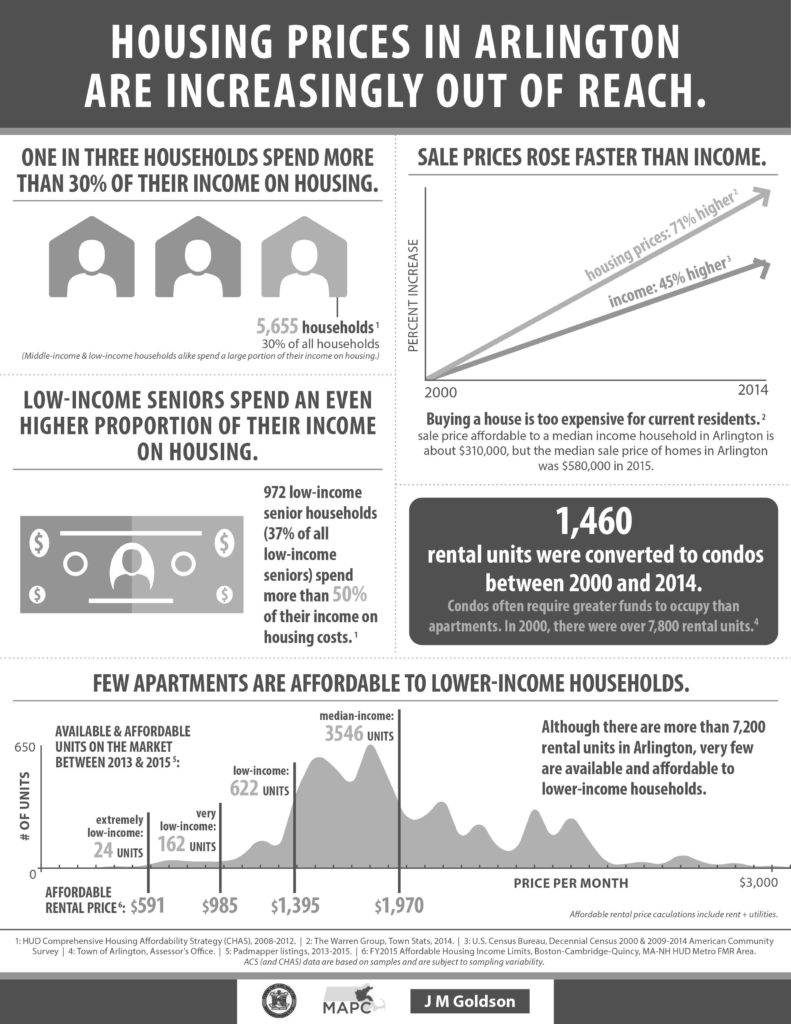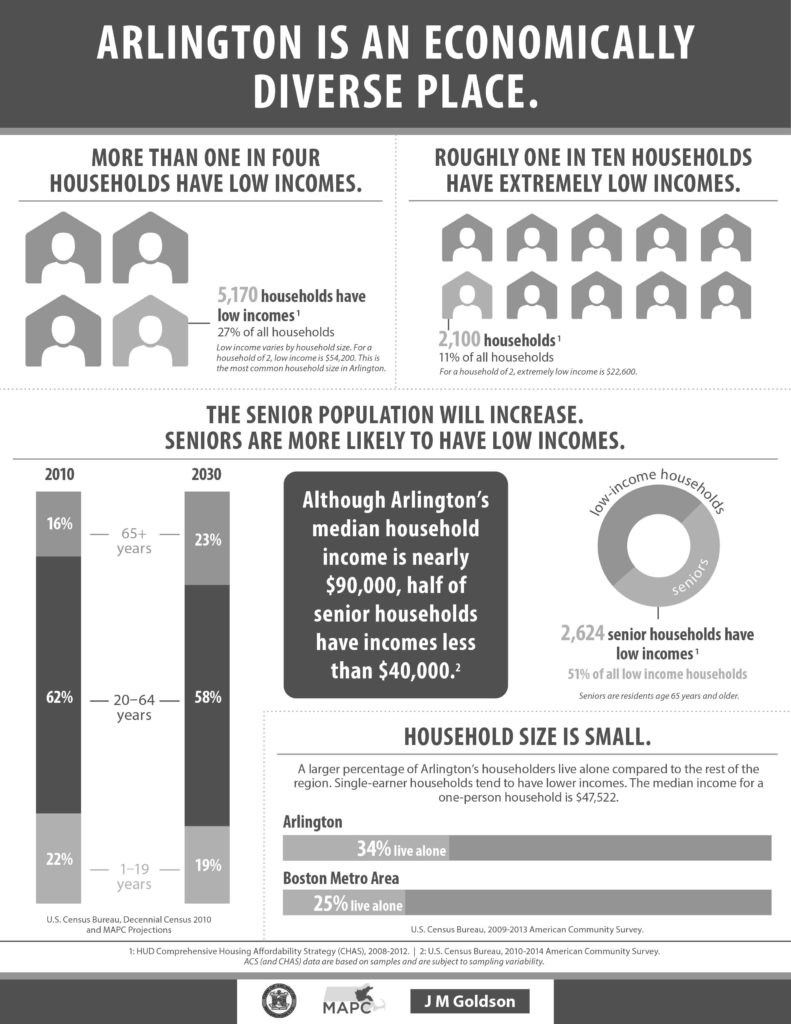In 2015 Town Meeting approved the Master Plan. Following is the Housing chapter of that plan. It contains a great deal of information about details of the housing situation in Arlington, challenges of housing price increases, needs for specialty housing, opportunities for meeting these needs, etc. The authors found that “most cities and towns around Arlington experienced a significant rise in housing values from 2000 to 2010. A 40 percent increase in the median value was fairly common. However, Arlington experienced more dramatic growth in housing values than any community in the immediate area, except Somerville. In fact, Arlington’s home values almost doubled.” This and related data helps explain why the need for affordable housing is now so acute.
Related articles

In a 2019 study, MAPC found that:
- Three out of ten spaces sit empty during peak demand
- The key factors that drive parking demand are parking supply, transit accessibility and the percentage of deed-restricted units
This study raises important questions about the wisdom of continuing to commit large sections of the land area of our municipalities to be on reserve for parking cars. Such extra space could be used to benefit the open space, environmental sustainability and the need for more housing.
(Contributed by HCA Board Member Laura Wiener, and Executive Director Erica Schwarz)
The Housing Corporation of Arlington (HCA), the Town’s non-profit housing developer, is excited to create a new development on Sunnyside Ave with 43 new affordable homes. The homes will be a diverse mix of sizes and serve people of different incomes, all under 60% of the area median income. Arlington and the entire Greater Boston region have a severe shortage of affordable housing, which this project will help to address. Arlington’s Master Plan, Housing Plan, and Housing Trust Action Plan all acknowledge the need to create significantly more affordable housing.
The HCA’s new Sunnyside Ave proposal is located just off Broadway, near the Alewife Brook DCR Greenway and the Somerville line; it’s a great location near a supermarket, bus lines, and a modest walk to Davis Square. Currently, the site is a dilapidated former auto body shop. The proposal is designed to meet the specific needs of HCA’s residents and the Arlington community. The development will be Passive House certified. It includes 21 vehicle parking spaces, approximately 70 bike parking spaces, and a 2nd floor roof garden for tenants to enjoy. The development also includes a community room that the HCA will share with other local groups. The project will also add a sidewalk on Sunnyside Ave where there currently isn’t one. HCA owns the site and expects to start seeking zoning approval in the spring.
Building affordable housing is a long and complicated process, due to the permitting process plus the number and complexity of funding sources needed. The state’s Department of Housing and Community Development receives many more requests than they can fund in every funding round. We expect to complete the permitting process in 2023, secure our financing by the end of 2024, and start construction in early 2025. With an expected construction timeline of around one year, HCA expects to see tenants moving into the building in spring, 2026. A public forum on the project is anticipated in the coming months. Given the complicated funding and permitting challenges, your monetary and public support of our new development on Sunnyside Ave would be appreciated.
The Housing Corporation of Arlington is a non-profit, community-based developer and owner of affordable housing in Arlington. It owns 150 units of affordable rental housing in all parts of town. The units are occupied by a diverse mix of families and individuals. HCA has been purchasing, rehabilitating, and building new housing since 2000, and also provides social service programs to support family stability and build community connection and engagement. Every week, HCA staff help local families who are struggling with the extreme cost of housing, making the creation of more affordable homes both urgent and important.
The staff, board of directors, and the more than 1,000 tenants, donors, and members who make up the HCA organization are very excited about this opportunity to expand Arlington’s portfolio of affordable housing. Our most recent projects included three newly constructed buildings—two in Downing Square (Lowell Street) and a mixed-use property shared with “Arlington Eats” on Broadway. To learn more about HCA or apply for housing, go to: https://www.housingcorparlington.org.
In the past few weeks, a number of highly respected Arlington organizations have come out in support of the MBTA Communities Plan. Here are a few. We will continue to update this list as it grows.
Greater Boston Interfaith Organization
This week the Greater Boston Interfaith Organization’s Arlington members released a letter of support, stating:
Arlington GBIO members support the Arlington Redevelopment Board’s proposal for the Article 12 of the Fall 2023 Special Town Meeting (MBTA Communities Overlay District) to enact changes in Arlington’s zoning by-laws that will allow for more multi-family housing to be built by right. We support an article that goes beyond the minimum capacity required by law in order to encourage the construction of a meaningful number of additional homes of various sizes beyond the number already present in Arlington.
Arlington Chamber of Commerce
The Arlington Chamber of Commerce sent a letter supporting the MBTA Communities Plan on October 2, saying:
The Arlington Chamber of Commerce believes that the MBTA Working Group’s proposal presents a strong plan for both housing and commercial growth. Arlington’s existing and future small businesses will benefit from an increased customer base and foot traffic resulting from additional housing units.
Division of Diversity, Equity and Inclusion
Arlington’s Division of Diversity, Equity and Inclusion wrote to the Arlington Redevelopment Board in support of the MBTA Communities Plan:
The DEI Division would like to formally voice our support for the Working Group’s effort to create a zoning plan that would allow for more multi-housing opportunities at varied price points across Arlington. Only 9% of Arlington’s land is devoted to multifamily housing, and even where building multi-family housing is allowable, it is not permitted by right. This does not provide suitable conditions for a range of housing types to exist. The current price point of homes in Arlington are far beyond the reach of most residents, regardless of their status as a member of a protected class. stating:
Read the full letter. [PDF]
Clean Energy Future Committee
The Clean Energy Future Committee said passage of the MBTA Communities Zoning was crucial because:
Passage of the MBTA Communities zoning amendment at this fall’s Special Town Meeting is the only viable pathway for Arlington to participate in the State’s Fossil Fuel Free Demonstration Program (Demonstration Program), which would allow implementation of the Clean Heat bylaw and home rule petition passed overwhelmingly by Arlington Town Meeting in 2020. Participation in the Demonstration Program will allow the Town to prohibit the installation of natural gas, oil, propane, and other fossil fuel infrastructure in new buildings and major renovations. Town Meeting sent a clear message in 2020 that enacting the Fossil Fuel Bylaw was a priority, and we–the CEFC, Town administrators, and elected and appointed bodies–have an obligation to act upon that priority; passage of the MBTA Communities zoning amendment is an essential step to carrying out the will of Town Meeting.
Mothers Out Front
As we previously reported, the Arlington chapter of Mothers Out Front supports the MBTA Communities Plan, writing:
A revised zoning by-law to allow for more multi-family housing will reduce pressure to build single family homes on undeveloped land elsewhere in Massachusetts. This safeguards undisturbed ecosystems and provides real alternatives to automotive commutes in the region, reducing both congestion and fossil fuel emissions.
Data in a Mass Housing Partnership report shows how far behind the Boston metropolitan area has fallen in meeting the housing needs of its citizens. There are four primary categories for measuring the inadequacies: 1. Availability, 2. Affordability, 3. L0cation and Mobility and 4. Equitability. See the full report for more data and examples. Two slides are shown below.
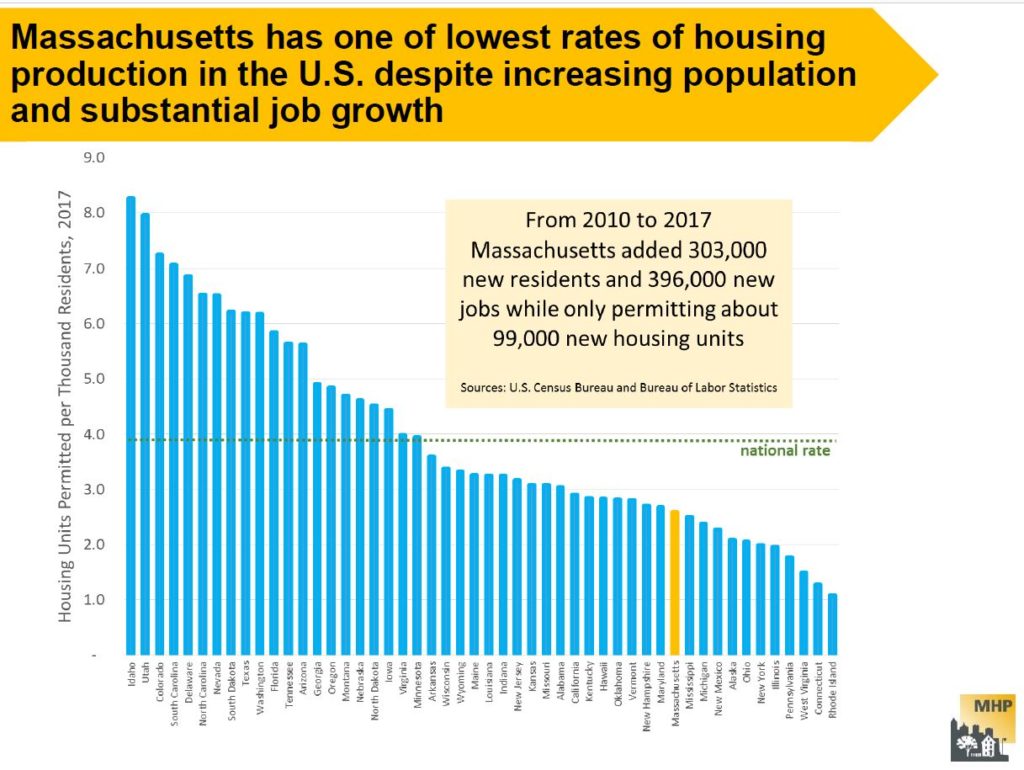
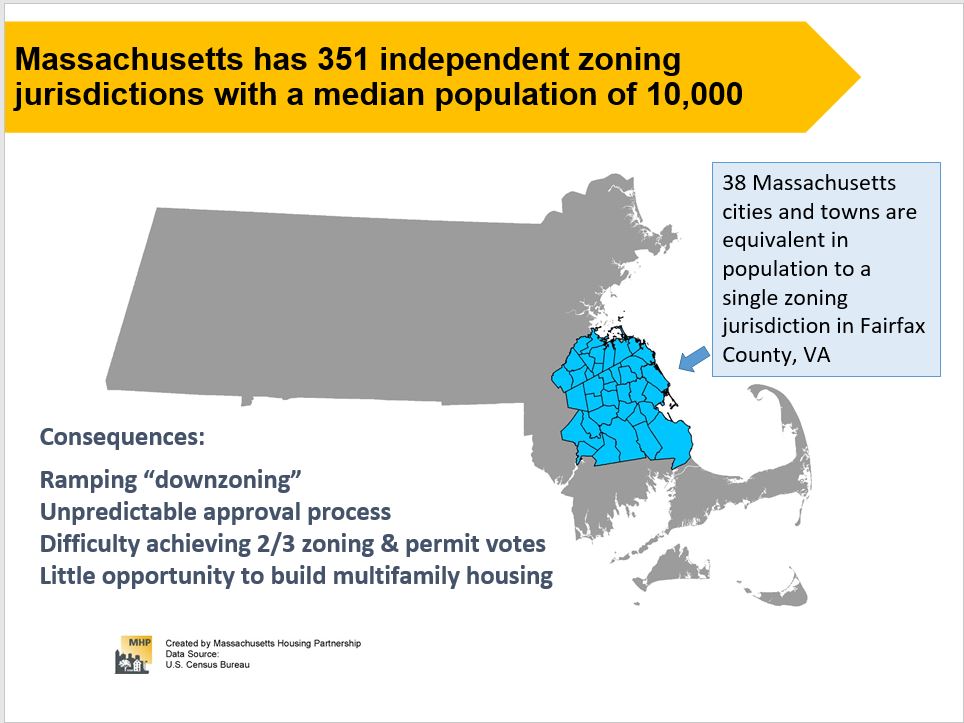
Two weeks ago, I helped to organize a precinct meeting for residents and town meeting members. During the meeting, we got into a discussion about public open spaces, how the town funds their upkeep, and whether having more commercial tax revenue might provide additional funding for parks and recreation.
As I discussed in an earlier post, only about 5.6% of Arlington’s is zoned for commercial uses, and that limits the amount of commercial property tax revenue we can generate. Commercial property tax revenue is sometimes referred to as “CIP”, which stands for “Commercial, Industrial, and Personal”. Commercial and Industrial refer to property taxes on land and buildings that are respectively used for commercial and industrial uses. Personal tax is tax on the value of equipment that’s owned and used by a business for the purpose of carrying out whatever their business is. This could include things like desks, display fixtures, cooking equipment, fork lifts, and the like.
In 2020, Arlington’s CIP levy was 5.45%, meaning that 5.45% of our property tax revenue came from Commercial, Industrial, and Property tax revenue. Breaking this down further, 4.2% was commercial ($5,562,528 tax levy), 0.2% was industrial ($278,351 tax levy), and 1.1% was personal ($1,423,117 tax levy). The town’s total 2020 tax levy was $133,350,155. This data comes from MassDOR’s Division of Local Services, and I’ll provide more specific sources in the “References” section of this post.
A CIP levy of 5.45% is low (compared with other communities in the commonwealth), and occassionaly folks like to talk talk about how to raise it. Which is to say, we about how to raise the ratio of commercial to residential taxes. I moved to Arlington in 2007, when our CIP levy was 5.37%. This increased in subsequent years, peaking at 6.26% in 2013, and has been gradually decreasing since. Recall that 2008 was the year the housing market crashed, and the “great recession” began. The value of Arlington’s residential property fell, but the value of business properties was relatively stable in comparison. Thus, our CIP percentage got a boost for a couple of years.
Tax levies (the amount of tax collected) are a direct reflection of the tax basis (the assessed value of property). I’m going to shift from talking about the former to talking about the latter, because that will lead nicely to a discussion about property wealth. Which is to say, the aggregate value of property assessments in town.
Here’s a chart showing Arlington’s net CIP and residential property values, from 1983–2020, adjusted to 2020 dollars. (This is similar to the chart that appears on page 102 of Arlington’s Master plan, but for a longer period of time).
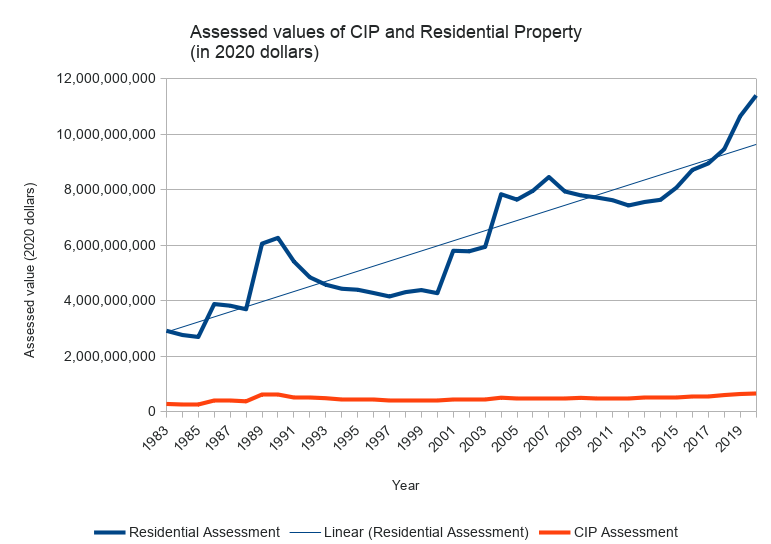
Generally speaking, the value of Arlington’s residential property has appreciated considerably, and there’s a widening gap between our residential and CIP assessments (in terms of raw dollars). Because the gap is so large, it’s helpful to see it on a log scale.
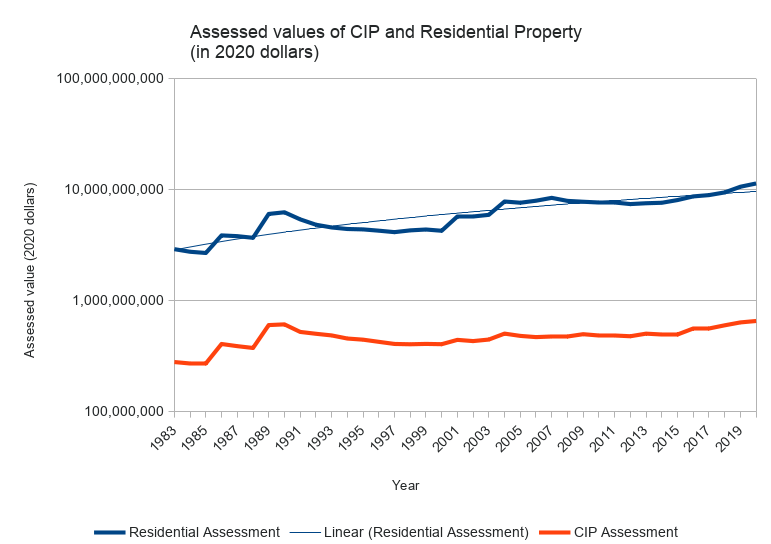
Viewed this way, the curvatures are generally similar, but residential property wealth is rising faster than business property wealth.
In summary, there are three reasons why our CIP is as low as it is: (1) a limited amount of land where one can run a business, (2) the value of residential property is appreciating faster than the value of business property, and (3) occasionally business properties are converted to residential (perhaps with the residential property being worth more than the former business property). That’s not to say we can’t improve the commercial tax base. We can, but we will have to think about what and where, and how to compete with a generally competitive residential market.
References
- MassDOR Division of Local Services reports
- DOR Query Tool for Municipal Property Assessments
- DOR Query Tool for Municipal Tax Levies
- Spreadsheet of Arlington Property Assessments, 1983–2020. Data obtained from MassDOR, with calculations added to adjust for inflation.
- Spreadsheet of Massachusetts Property assessments for 2020. Data obtained from MassDOR.
(Updated 7/2/2020, to add log scale graph and revise conclusion.)
Why Is This Our Issue & What Should We Do About It?
(presented by Adam Chapdelaine, Town Manager, to Select Board on July 22, 2019)
Overview
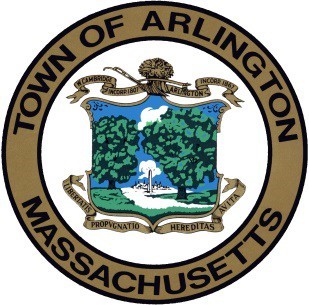
Since 1980 the price of housing in Massachusetts has surged well ahead of other fast growing states including California and New York. While the national “House Price Index” is just below 400, four times what an average house might have cost in 1980, a typical house in Massachusetts is now about 720% what it was in 1980. Median household income in the state has only increased about 15% during the same period. No wonder people in Arlington are feeling the stresses of housing costs if they want to live here and are feeling protective of the equity value time has provided them if they bought years ago.
In response to concerns about zoning, affordable housing and housing density, the Town joined the “Mayors’ (and Managers’) Coalition on Housing” to address these growing pressures. This 12 page slide deck presentation outlines the key data points, the number of low and very low income households in Arlington, the rate of condo conversion that is absorbing rental units, etc.
Solutions are offered including:
• Amendments to Inclusionary Zoning Bylaw
• Housing Creation Along Commercial Corridor – Mixed Use & Zoning Along Corridor
• Accessory Dwelling Units – Potential Age & Family Restrictions
• Other Tools Can Be Considered That Are Outside of Zoning But Have An Impact on Housing
Chapdelaine’s suggested next steps are:
• Continued Public Engagement
• Town Manager & Director of DPCD Meet with ARB
• Select Board & ARB Hold Joint Meeting in Early Fall
• ARB Recommends Strategies to Pursue in Late Fall/Early Winter
The Select Board approved the suggested next steps and a joint ARB/ Select Board meeting should be scheduled in the near future.
Note from Reporter: As a community, Arlington has long prided itself on its economic diversity. With condo conversions, tear downs leading to “McMansions”, higher paid workers arriving in response to new jobs, etc., Arlington is at great risk of losing this diversity that has long enriched the community. Retirees looking to downsize and young people who have grown up in Arlington looking for their first apartment are finding it impossible to stay in town. Shop keepers and town employees are challenged to afford the rising housing costs. With a reconsideration of zoning along Arlington’s transit corridors, Arlington NOW has an opportunity to create new village centers, like those recommended in the recent STATE OF HOUSING report. These village centers along our transit corridors could be higher, denser but also offer the compelling visual design and amenities desired by people who want to walk to cafes, shops and public transit.
Text of Warrant Article 8: (To be considered at Special Town Meeting (Virtual), Mon. 11/16/20 at 8:00 p.m.)
“ARTICLE 8 ACCEPTANCE OF LEGISLATION/BYLAW AMENDMENT/ MUNICIPAL AFFORDABLE HOUSING TRUST FUND
To see if the Town will vote to accept Massachusetts General Laws c. 44 § 55C, to authorize the creation of a Municipal Affordable Housing Trust Fund to support the development of affordable housing in Arlington, establish a new bylaw for the administration of same; or take any action related thereto. (Inserted by the Select Board)”
What will it do? How will it work?
A Proactive Step to Address Housing Affordability. With a municipal affordable housing trust, Arlington will join more than 113 Massachusetts municipalities that have formed a housing trust fund to support a proactive strategy for building housing affordability. The Trust is a small step the Town can take to more proactively address the housing affordability crisis that challenges many of our current residents and makes Arlington increasingly inaccessible to new residents. Creating affordable housing can also be a strategy for maintaining or increasing diversity.
Ability to Act Quickly.
A primary benefit of a housing trust is to enable the Town to act quickly to support or participate in transactions that increase or preserve affordable housing in Arlington. Without a Trust, the Town does not have the flexibility or agility to act quickly. Following are some examples, though there are many other ways that trusts can and do advance housing affordability:
• Financing the acquisition and/or development of market properties for conversion to affordable housing by a nonprofit developer;
• Purchasing an existing affordable home to ensure resale to another low income buyer, or purchasing a market rate home to create an affordable homeownership opportunity;
• Providing flexible financing to increase the number of affordable units or reduce income levels in existing or new projects that include affordable housing.
Developing a Housing Trust Strategy Over Time.
The strategies to be pursued by the Trust would be set forth by the Trustees in a plan or proposal(s) they would lay out after they are appointed, most likely after/through a process of public engagement. The specific strategies are, deliberately, not part of the warrant article or the Bylaw proposed for adoption. This allows the Town the flexibility to set and modify the Town’s housing strategies over time, in a manner that is responsive to the public and its elected representatives. The Bylaw requires the strategy or plan, and most major Trust decisions, to be approved by the Select Board, and Town investments in the Trust would still require Town Meeting approval.
Funding the Affordable Housing Trust Fund.
Creating affordable housing requires substantial subsidy. The Trust’s ability to cause more affordable housing to be created or preserved in Arlington will be directly related to the availability of resources to fund it and leverage additional state and federal resources. The vote before the Special Town Meeting this fall will not provide any funding for the Trust.
While it is anticipated that the Trust might receive initial funding via a grant of Community Preservation Act funds from the CPA Committee, to increase our impact, more resources will be needed.
How Other Communities Fund Their Housing Trust Funds.
The Community Preservation Act is the most common source of funding, but the most impactful trusts tend to have a variety of funding sources that result in a steady flow of financial resources into the Trust. Other municipalities have tapped into a variety of additional sources, including inclusionary zoning payments, federal HOME funds, voluntary/negotiated developer payments, proceeds from sale of tax foreclosed or other Town-owned properties, cell tower payments, cannabis-related revenue, short-term rental fees, fees for managing housing lotteries, sale of bonds, general municipal funding, and private donations. Many also donate excess town property to their housing trust for sale and redevelopment as affordable or mixed income housing. More recently, a number of cities and towns have proposed home rule petitions that would allow them to impose a small fee on the transfer of real property to fund their housing trusts, and there is state legislation proposed to authorize cities and towns to impose such transfer fees without sending a Home Rule Petition to the state legislature.
Building Trust Resources Through a Transfer Fee.
The Housing Plan Implementation Committee originally recommended that Town Meeting adopt a bylaw creating a housing trust and create a funding source for it by voting to authorize the filing of a home rule petition to impose a modest real estate transfer fee. Although the Select Board elected to defer consideration of the transfer fee until 2021, such a fee is attractive to many, because it would be borne only by those selling their Arlington homes or properties, and because it provides a mechanism to capture a very small portion of the extraordinary equity increase that Arlington property owners have realized over many years due to regional market forces. The details of such a fee are important and merit further discussion, but it presents a promising potential revenue source to empower the Trust to be proactive.
The Process.
The article in front of the Special Town Meeting would start the process of creating a municipal affordable housing trust. Once approved by Town Meeting the Affordable Housing Trust Bylaw would be submitted to the Attorney General to certify its consistency with the state law governing housing trusts within 90 days. Once so certified, the Town Manager will appoint trustees, including at least one member of the Select Board. Once these appointments are confirmed by the Select Board, the Trustees themselves would lead the process of proposing an initial set of goals and strategies for the Trust to implement, after approval by the Select Board.
Financial Stability & Accountability.
The Trust will be governed by the MAHT law passed in 2005 that specifies powers and limitations for trusts of this type. The proposed Bylaw has been reviewed and modified pursuant to suggestions of the Finance Committee to ensure accountability and financial stability. The Trust will be managed by the Treasurer, will be audited annually, will have legal and practical limitations on its borrowing capacity, and will not have the power to pledge the full faith and credit of the Town.
To learn more about municipal affordable housing trusts, refer to the MHP Municipal Affordable Housing Trust Fund Guide, v.3
******
This information was prepared by Karen Kelleher, Arlington Town Meeting Member, Precinct 5, Member, Arlington Housing Planning Implementation Committee and Executive Director, LISC Boston ( Local Initiative Support Corporation)
